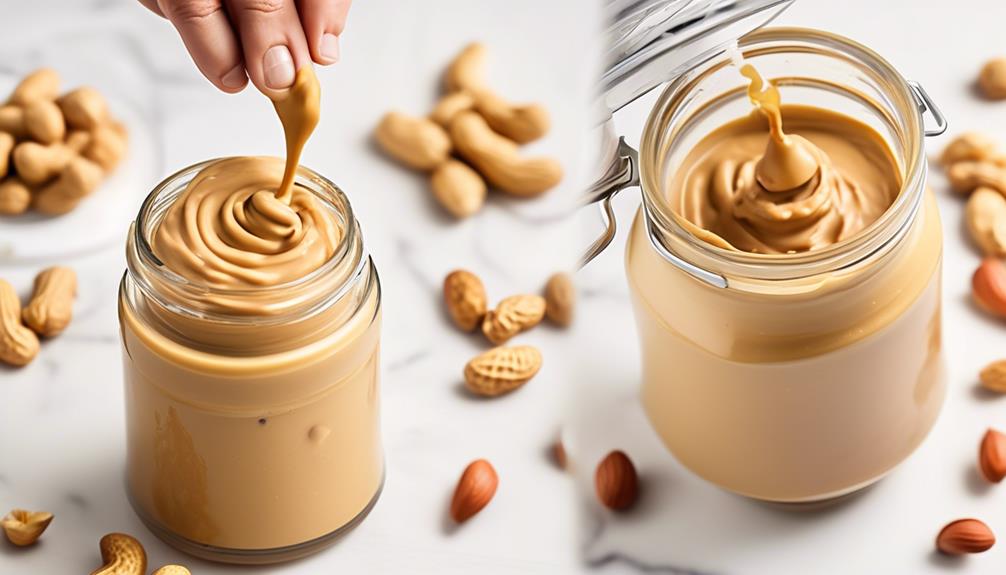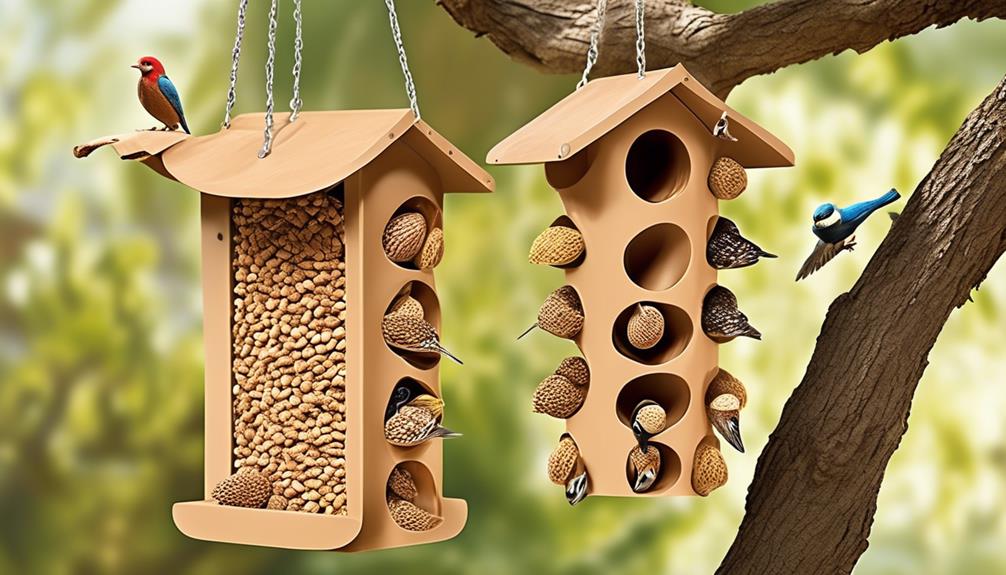Organic peanut butter usually contains lower aflatoxin levels than conventional options because organic farming uses stricter standards, better crop management, and testing procedures that reduce mold growth. Conventional methods often rely on synthetic chemicals, which can increase the risk of contamination. This difference means you may be safer choosing organic. To understand how these practices impact aflatoxin content and find the best options, explore further details about testing methods and farm practices.
Key Takeaways
- Organic peanut butter typically undergoes stricter testing and regulation, potentially resulting in lower aflatoxin levels.
- Conventional farming often uses synthetic pesticides, which may influence mold growth and aflatoxin contamination risk.
- Proper crop rotation and natural pest control in organic practices reduce fungal buildup compared to conventional methods.
- Testing methods and standards can vary between organic and conventional brands, affecting reported aflatoxin levels.
- Consumers should review brands’ testing disclosures and quality controls to better compare aflatoxin safety in both types.
Understanding Aflatoxin and Its Sources
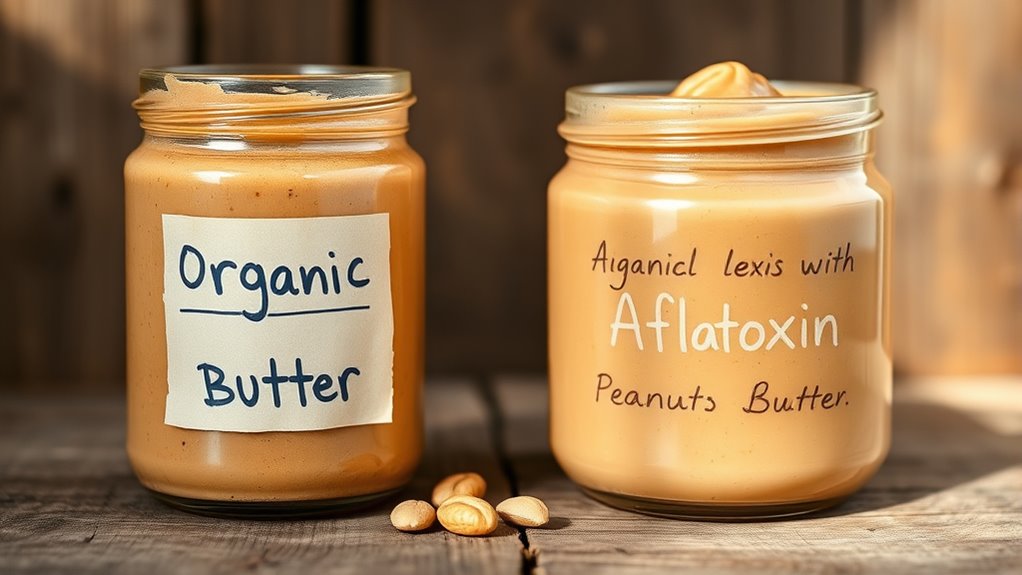
Have you ever wondered what causes aflatoxin to appear in foods like peanut butter? Aflatoxin is a toxin produced by certain molds, mainly Aspergillus flavus and Aspergillus parasiticus, which contaminate crops during cultivation or storage. Crop contamination occurs when these molds grow on peanuts exposed to warm, humid conditions, especially if harvest and storage practices are poor. To protect consumers, aflatoxin regulation sets strict limits on allowable levels in food products, including peanut butter. Proper crop handling and storage are crucial in preventing mold growth and subsequent aflatoxin development. Understanding these sources helps you recognize the importance of proper crop handling and storage. When mold-contaminated peanuts are used, aflatoxin can enter the food supply, posing health risks. Being aware of these factors underscores the importance of regulation and vigilance in preventing contamination.
How Organic and Conventional Farming Practices Differ

Organic and conventional farming practices differ markedly in how they manage crop growth and control for contamination risks like aflatoxin. Organic farmers prioritize soil fertility through composting and crop rotation, which promotes healthy plants naturally. They also rely on natural pest control methods, such as beneficial insects and biological pesticides, reducing chemical residues. In contrast, conventional farmers often use synthetic fertilizers to boost soil nutrients quickly and chemical pesticides to manage pests efficiently. This approach can influence crop health and susceptibility to contamination. To summarize: 1. Organic farming enhances soil fertility naturally, reducing stress on plants. 2. Pest control relies on biological methods rather than chemicals. 3. Conventional farming emphasizes chemical inputs for rapid growth. 4. These practices directly impact crop quality and aflatoxin risk potential. Additionally, the use of sustainable practices in organic farming can contribute to healthier crops less prone to toxin development.
Factors Affecting Aflatoxin Levels in Peanut Crops
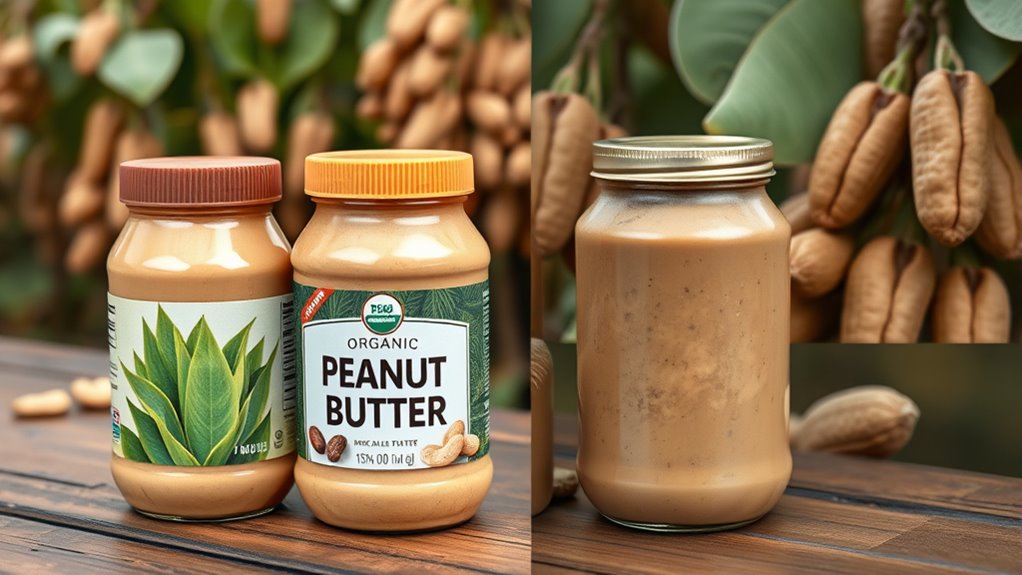
Several environmental and agricultural factors influence aflatoxin levels in peanut crops. Your choices, like crop rotation and pest management, play essential roles. Proper crop rotation reduces soil contamination and disrupts fungal growth cycles. Pest management minimizes damage to peanuts, preventing entry points for fungi that produce aflatoxins. The table below highlights key factors:
| Factor | Impact |
|---|---|
| Crop Rotation | Decreases fungal buildup |
| Pest Management | Limits pest-related damage |
| Climate Conditions | Warm, humid weather promotes fungi |
Additionally, understanding fungal growth conditions helps in developing effective prevention strategies.
Comparing Testing Methods and Results in Peanut Butter Samples
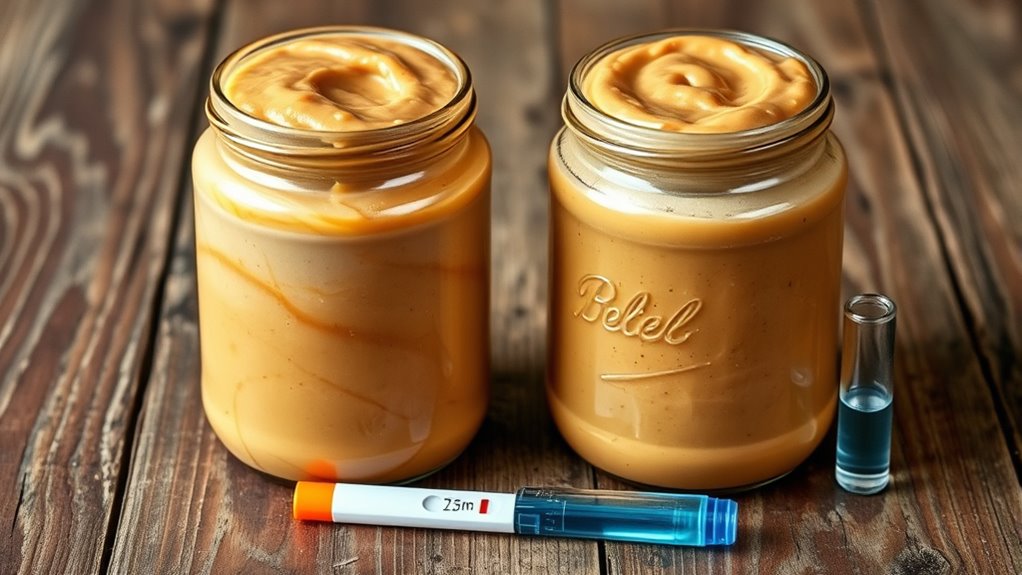
Different testing methods can produce varying results when analyzing aflatoxin levels in peanut butter samples. To guarantee testing accuracy, proper sample preparation is essential, as it influences the reliability of results. Different techniques, such as ELISA, HPLC, and TLC, each have strengths and limitations. When comparing results, consider:
- The sensitivity of the testing method to detect low aflatoxin concentrations
- The consistency of sample preparation procedures
- The potential for cross-reactivity or interference in assays
- The calibration and validation processes used in each testing technique
Additionally, understanding the methodology behind each testing process helps ensure accurate interpretation of the data.
Understanding these factors helps you interpret data more accurately. Variations in testing methods highlight the importance of standardized protocols to reduce discrepancies and improve confidence in aflatoxin level assessments in peanut butter samples.
Making Informed Choices for Safer Peanut Butter Consumption

To make safer choices when consuming peanut butter, it’s important to stay informed about aflatoxin levels and testing practices. Look for brands that clearly disclose testing procedures and quality standards, ensuring you’re choosing products with low aflatoxin risk. While peanut butter offers nutritional benefits like protein, healthy fats, and vitamins, contamination can compromise safety. Consider trying organic options, which often have stricter regulations and testing, reducing potential aflatoxin exposure. Additionally, pay attention to flavor profiles, as high-quality peanut butter typically has a richer, more natural taste. Being aware of testing standards can further help you select safer, high-quality products confidently. By making informed decisions, you can enjoy peanut butter’s nutritional benefits and complex flavors while minimizing health risks associated with aflatoxin. Knowledge empowers you to select safer, high-quality products confidently.
Frequently Asked Questions
Do Organic Peanut Butters Generally Contain Less Aflatoxin Than Conventional Ones?
You might wonder if organic peanut butters contain less aflatoxin. Organic farming minimizes pesticide residues, but it doesn’t necessarily prevent aflatoxin contamination, which depends on mold growth during crop storage. Aflatoxin levels can vary regardless of farming methods. While some believe organic practices reduce risks, it’s best to check labels or testing reports, as both organic and conventional peanut butters can contain varying aflatoxin levels based on storage and handling.
How Does Storage Affect Aflatoxin Levels in Peanut Butter?
Oh, the grand adventure of peanut butter storage—truly a saga! You see, poor storage conditions invite mold growth, which ramps up aflatoxin levels. Keep your jar in a cool, dry place, and avoid the humid chaos that fuels mold. By doing so, you prevent those sneaky toxins from flourishing, ensuring your peanut butter remains safer and tastier. Who knew storage could be so essential to health?
Are There Specific Brands Known for Low Aflatoxin Contamination?
You should look for brands with a strong reputation for safety and quality. Trust those that prioritize testing transparency, openly sharing aflatoxin testing results. Such brands often conduct rigorous testing and maintain high-quality standards, reducing your risk of contamination. By choosing reputable brands committed to transparency, you can enjoy peanut butter with lower aflatoxin levels and better peace of mind. Always check for clear labeling and third-party testing information.
Can Aflatoxin Levels Vary Between Different Peanut Varieties?
You might be surprised that peanut variety can influence aflatoxin levels, as certain varieties are more toxin susceptible. Different peanut types have unique traits, making some more prone to mold growth and toxin production under specific conditions. So, when choosing your peanuts, consider the variety, because it can impact the risk of aflatoxin contamination. Selecting less toxin-susceptible varieties helps reduce your exposure to this harmful toxin.
What Regulatory Standards Exist for Aflatoxin in Peanut Products?
You should know that regulatory thresholds for aflatoxin in peanut products are set to protect consumers, typically around 20 parts per billion (ppb) in many countries. Testing protocols involve sampling and laboratory analysis to verify compliance. As a consumer, it’s reassuring to understand that strict standards exist and are enforced, helping to minimize health risks from contaminated peanuts. These regulations help maintain safety across both organic and conventional peanut products.
Conclusion
When it comes to choosing peanut butter, remember the saying, “You are what you eat.” Both organic and conventional options can contain aflatoxins, but testing shows levels vary. Staying informed helps you make safer choices, so look for brands that prioritize quality testing. Ultimately, moderation is key—because an ounce of prevention is worth a pound of cure. Choose wisely and enjoy your peanut butter without worry!



